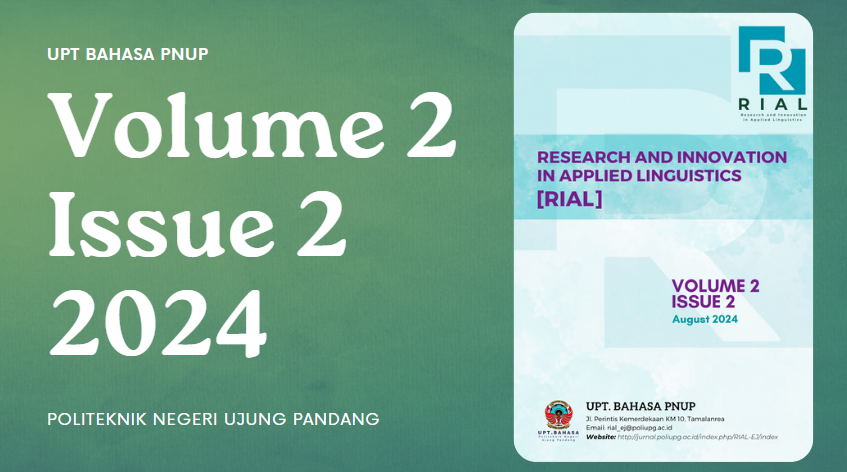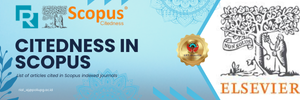The Photovoice Project: Fostering Students' Autonomous, Collaborative, and Authentic Business/Engineering English Learning Experiences
DOI:
https://doi.org/10.31963/rial.v2i2.4869Keywords:
In vocational colleges, project-based learning is an instructional strategy for creating autonomous, collaborative, and authentic learning nuances. This article sheds light on how photovoice project fosters the students’ business English learning experienAbstract
This perspective article elaborates an instructional approach to business English learning utilizing a photovoice project as a strategy to promote a real-world learning encounter. In professional and vocational colleges, project-based learning (PBL) is an instructional strategy for promoting autonomous, collaborative, and authentic learning nuances. This article sheds light on how photovoice project fosters the students’ technical and business English learning experiences. The project empowers students to take charge of their learning, work collaboratively, and engage in real-world business context. This paper presents the concept of photovoice, learners’ autonomy and collaboration towards photovoice, authentic business English learning encounters, technology-integrated photovoice, project evaluation, and case studies on photovoice project. On top of that, language teachers can utilize project-based photovoice as a valuable tool for promoting innovative and engaging business English learning activities, thus providing students with contextual-based learning environment and preparing them for the real business world. It also brings several implications: 1) for vocational English teachers, implementing photovoice projects offers a powerful tool to create innovative and engaging learning activities, 2) for students, these projects provide a contextualized learning environment that prepares them for the real business world by developing practical language skills and industry-specific knowledge, and institutions will benefit by fostering an educational approach that bridges classroom learning with real-world applications, thereby enhancing the overall quality and relevance of their programs.References
Anas, I., & Nur, S. (2022). Digital photovoice: Integrating environmental issues in language education. Mextesol, 46(4).
Anas, I., Sahriana, S., & Pasolong, H. (2021). Project-based language learning with technology to promote the student’s active, autonomous, and collaborative learning. Seminat Nasional Penelitian Dan Pengabdian Kepada Masyarakat (SNP2M), 78–83. http://jurnal.poliupg.ac.id/index.php/snp2m/article/view/3272
Andrews, T. (2004). Incorporating authentic learning experiences within a university course. Studies in Higher Education, 29(2), 239–258.
Baker, T. A., & Wang, C. C. (2006). Photovoice: Use of a participatory action research method to explore the chronic pain experience in older adults. Qualitative Health Research, 16(10), 1405–1413. https://doi.org/10.1177/1049732306294118
Bereczki, E. O., & Kárpáti, A. (2021). Technology-enhanced creativity: A multiple case study of digital technology-integration expert teachers’ beliefs and practices. Thinking Skills and Creativity, 39, 100791. https://doi.org/10.1016/j.tsc.2021.100791
Christensen, M. C., Capous-Desyllas, M., & Arczynski, A. V. (2020). Photovoice as a Multilevel Tool for Gender and Sexual Identity Exploration. Families in Society, 101(2), 1–13. https://doi.org/10.1177/1044389419889710
Díez, J., Conde, P., Sandin, M., Urtasun, M., López, R., Carrero, J. L., Gittelsohn, J., & Franco, M. (2017). Understanding the local food environment: A participatory photovoice project in a low-income area in Madrid, Spain. Health and Place, 43(October 2016), 95–103. https://doi.org/10.1016/j.healthplace.2016.11.012
Edwards, M., Perry, B., Janzen, K., & Menzies, C. (2012). Using the artistic pedagogical technology of photovoice to promote interaction in the online post-secondary classroom: The students’ perspective. The Electronic Journal of E-Learning, 10(1), 32–43.
Erbaggio, P., Gopalakrishnan, S., Hobbs, S., & Liu, H. (2012). Enhancing Student Engagement through Online Authentic Materials. The IALLT Journal, 42(2), 27–51. https://doi.org/https://doi.org/10.17161/iallt.v42i2.8511
Evans-Agnew, R. A., & Strack, R. W. (2022). Photovoice: The Little Method That Could Change the World. Health Promotion Practice, 23(2), 201–204. https://doi.org/10.1177/15248399211069151
Foster, K. A., Davis, B., & Foell, A. (2023). Innovations to Photovoice: Using Smartphones & Social Media. Urban Affairs Review, 59(5), 1728–1744. https://doi.org/10.1177/10780874221100263
Henderson, J. A., McGowan, B. L., Wawire, J., Benjamin, L. S. S., Schaefer, K. L., & Alarcón, J. D. (2023). Photovoice: Visualizing the engineering identity experiences of sophomore students. Journal of Engineering Education, 112(4), 1145–1166. https://doi.org/10.1002/jee.20555
Hoffmann, M. (2024). Photovoice Reflections of Preservice Teacher Perceptions of Effective Technology Integration. Journal of Educators Online, 21(2), 46–58. https://doi.org/10.9743/JEO.2024.21.2.18
Horwitz, J. R. (2012). Photovoice as a critical reflection methodology. In R. Flessner, G. R. Miller, K. M. Patrizio, & J. R. Horwitz (Eds.), Agency through Teacher Education: Reflection, Community, and Learning (pp. 15–24). Rowman & Littlefield Education in partnership with the Association of Teacher Educators.
Jenkins, C. (2011). Authenticity through reflexivity: connecting teaching philosophy and practice. Australian Journal of Adult Learning, 51, 72–89. https://files.eric.ed.gov/fulltext/EJ973633.pdf
Kokotsaki, D., Menzies, V., & Wiggins, A. (2016). Project-based learning: A review of the literature. Improving Schools, 19(3), 267–277. https://doi.org/10.1177/1365480216659733
Laur, D. (2013). Authentic learning experiences: A real-world approach to project-based learning. Routledge: Taylor & Francis Group.
López, E. D. S., Eng, E., Robinson, N., & Wang, C. C. (2005). Photovoice as a community-based participatory research method: A case study with African American breast cancer survivors in rural Eastern North Carolina. In B. A. Israel, E. Eng, A. J. Schulz, & E. A. Parker (Eds.), Methods in Community-Based Participatory Research for Health (pp. 326–348). Jossey-Bass. https://doi.org/10.1177/1090198106288490
Madoyan, L. (2016). Authenticity and teacher’s role in project based learning. Armenian Folia Anglistika, 12(2), 109–114. https://journals.ysu.am/index.php/arm-fol-angl/article/view/Vol.12_No.2_2016_pp.109-114
Malka, M. (2020). Photo-voices from the classroom: Photovoice as a creative learning methodology in social work education. Social Work Education, 00(00), 1–17. https://doi.org/10.1080/02615479.2020.1789091
Massengale, K. E. C., Strack, R. W., Orsini, M. M., & Herget, J. (2016). Photovoice as Pedagogy for Authentic Learning: Empowering Undergraduate Students to Increase Community Awareness About Issues Related to the Impact of Low Income on Health. Pedagogy in Health Promotion, 2(2), 117–126. https://core.ac.uk/download/pdf/196255896.pdf
Schell, K., Ferguson, A., Hamoline, R., Shea, J., & Thomas-maclean, R. (2009). Photovoice as a teaching tool: Learning by doing with visual methods. International Journal of Teaching and Learning in Higher Education, 21(3), 340–352.
Sutton-brown, C. A. (2014). Photovoice : A methodological guide. Photography and Culture, 7(2), 169–185. https://doi.org/10.2752/175145214X13999922103165
Thomas, M. (2017). Project-based language learning with technology: Learner collaboration in an EFL classroom in Japan. Routledge. https://doi.org/10.4324/9781315225418
Wang, C., & Burris, M. A. (1997). Photovoice: Concept, methodology, and use for participatory needs assessment. Health Education and Behavior, 24(3), 369–387. https://doi.org/10.1177/109019819702400309
Wang, S. (2020). Project-based language learning in China: A literature review. Journal of Language Teaching and Research, 11(1), 66–72.
Warne, M., Snyder, K., & Gadin, G. K. (2013). Photovoice: An opportunity and challenge for students’ genuine participation. Health Promotion International, 28(3), 299–310. https://doi.org/10.1093/heapro/das011
Yuliani, Y., & Lengkanawati, N. S. (2017). Project-based learning in promoting learner autonomy in an EFL classroom. Indonesian Journal of Applied Linguistics, 7(2), 285–293.
Downloads
Published
Issue
Section
License
Copyright (c) 2024 Research and Innovation in Applied Linguistics [RIAL]

This work is licensed under a Creative Commons Attribution-ShareAlike 4.0 International License.
Authors who publish with this journal agree to the following terms:
Authors who submit article to this journal, agree to grant the copyright to Research and Innovation in Applied Linguistics (RIAL) under a Creative Commons Attribution License: Creative Commons Attribution-ShareAlike 4.0 International License.
![]()
For collaborative works, authors should ensure that they have secured the necessary permissions from co-authors to submit the manuscript and grant the rights outlined in this policy.
Archiving and Access:
RIAL upholds an open access policy, ensuring that articles are freely accessible to a global audience upon publication. Authors' work will be archived electronically, facilitating its long-term availability and visibility.








.png)


